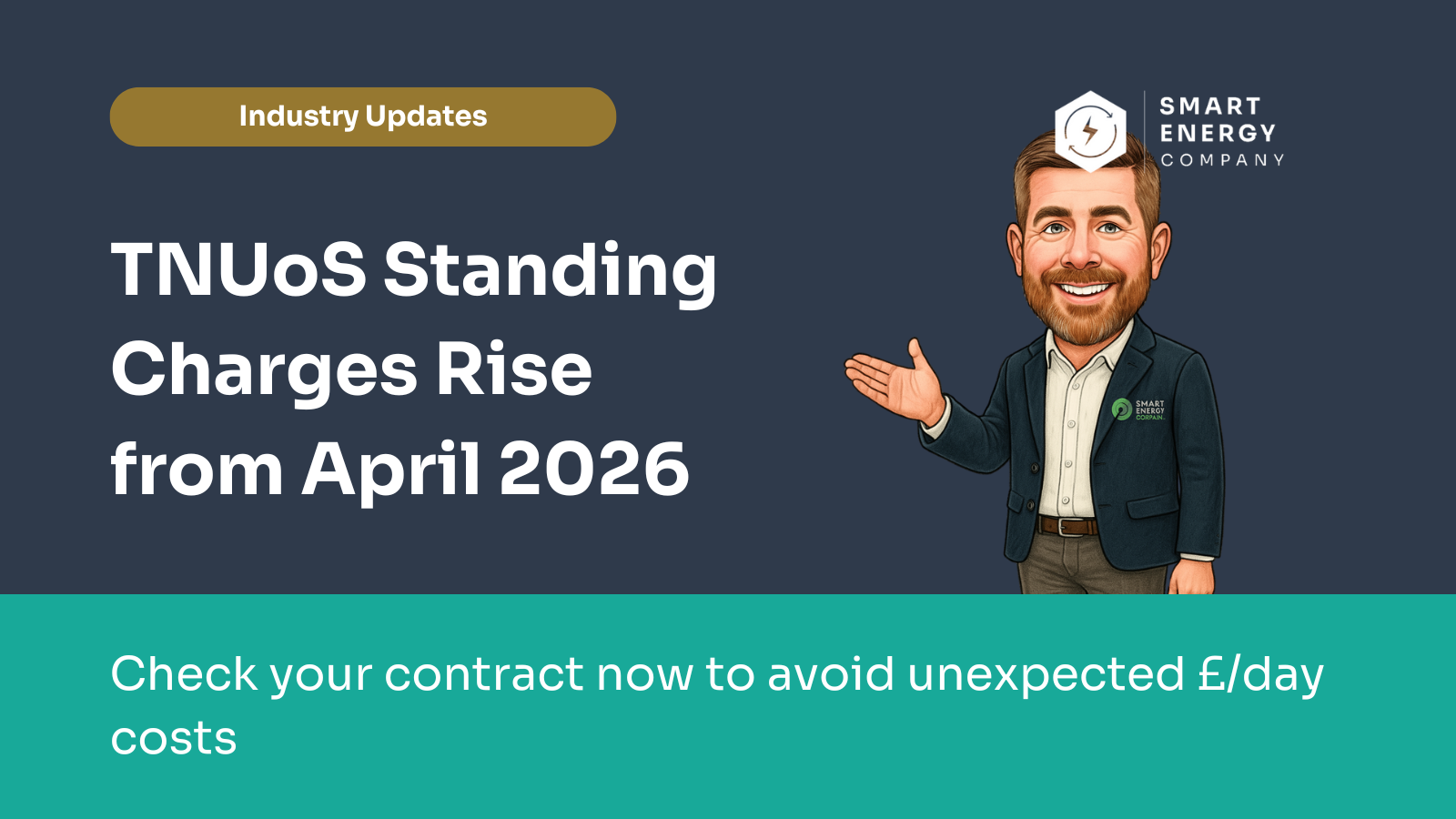⚡ Upcoming TNUoS Changes: What They Mean for Your Business

From 1 April 2026, business electricity standing charges are forecast to rise sharply. The main driver is higher TNUoS (Transmission Network Use of System) costs, which fund the UK's transmission grid.
Because TNUoS residuals are charged £/site/day by meter/voltage band (not per kWh or kVA), every organisation with an electricity supply is affected.
Key Takeaways
- Standing charges will rise significantly from April 2026.
- TNUoS is the main reason: the demand-residual pot (TDR) is forecast ~+94% YoY in 2026/27.
- These increases are per meter — not per kWh, not per kVA.
- Most suppliers treat TNUoS as pass-through, so even "fixed" contracts can see mid-term standing-charge changes if they run past April 2026.
- A small number of contracts explicitly fix TNUoS in the Contract Pack — check yours.
- Plan now: understand your banding, review your T&Cs, and budget using the latest forecasts.
- Draft tariffs due by 30 Nov 2025; final tariffs due by 31 Jan 2026 (go-live 1 Apr 2026).
What's Changing in Your Standing Charge?
Current NESO forecasts show the TDR pot(what the fixed residual recovers) rising to £7.52bn in 2026/27, about +94% versus 2025/26. That uplift flows directly into the standing charge suppliers quote.
| Meter Type | 2025/26 TDR (£/day) | 2026/27 TDR (£/day) | Daily Increase | Annual Impact* |
|---|---|---|---|---|
| Small Business (NHH Medium) |
£0.760709 | £1.598634 | +£0.838 | ~£306 |
| HH LV1 (0–80 kVA) |
£3.907710 | £7.275302 | +£3.368/day | ~£1,230 |
| HH LV2 (80–500 kVA) |
£6.529117 | £14.408552 | +£7.879/day | ~£2,876 |
*365-day illustration. These figures isolate the TNUoS portion of the standing charge.
💡 These are per-meter increases — not per kVA, not per kWh — and they apply regardless of how much energy you use.
Rising Standing Charges? Offset Them With Real Savings
How Much Could You Save?
A single incorrectly set kVA capacity can waste £10,000+ annually. Our free analysis shows your exact savings potential.
Takes 5 minutes. No obligation. Results in 7–14 days.
Will my unit rate go up too?
For most SMEs, only a little.
Non-HH
A small p/kWh add-on applies to 4–7pm usage (varies by zone; average forecast around the low tenths of a penny per kWh).
HH
The locational element is a £/kW line item (not part of the p/kWh).
The standing charge (TDR) is the key change to plan for.
North vs South (locational element)
Separate from the fixed TDR, the locational demand element is generally ~£0 in the North and >£0 in the South due to power flows toward southern demand centres. It matters for budgeting, but the big 2026 jump is still the fixed TDR.
ℹ️ Real-world impact varies by region, meter type and tariff structure. Always check your contract pack.
Standing Charges Are Rising
Ensure you're on the cheapest rates — compare 28+ suppliers in minutes.
Get My Free Quote →What If I'm Already in a Fixed-Term Contract That Runs Beyond April 2026?
Many businesses assume a "fixed" contract locks in every part of the bill. Most supplier terms say otherwise for TNUoS.
⚠️ Even if you're in a "fixed" deal, your standing charges may still increase mid-contract if TNUoS is treated as pass-through.
What Supplier T&Cs Say
Summary of how major suppliers treat TNUoS charges
| Supplier | How TNUoS is Treated | Pass-Through Allowed? | Can Change Mid-Contract? |
|---|---|---|---|
| TEM | Explicitly listed as Pass-Through | ✅ Yes | ✅ Yes |
| Valda Energy | Defined under "Non-Commodity Costs" | ✅ Yes | ✅ Yes (anytime) |
| British Gas | Transmission/Distribution charges | ✅ Yes | ✅ Yes |
| EDF | Can be Fixed or Pass-Through depending on your Contract Pack | ✅ Yes (if pass-through) | ✅ Yes (if pass-through) |
| SSE | "Use of System" charges | ✅ Yes | ✅ Yes (updated quarterly) |
| ScottishPower | "Non-Commodity Costs / Use of System" | ✅ Yes | ✅ Yes (updated quarterly) |
| npower | Lists TNUoS under "Third-Party Charges" | ⚠️ Likely | ⚠️ Likely |
💡 In plain English: Even if you're already in a fixed deal, most suppliers don't fix TNUoS. That means if your contract runs into or beyond April 2026, your standing charge is likely to rise when the new higher TDR comes in.
What to Check in Your Own Contract
Open your Contract Information Pack (CIP) or T&Cs and look for:
Key Terms to Find
- ✓
"Pass-Through Costs"
This term indicates charges that can be adjusted outside your fixed rate.
- ✓
"Non-Commodity Costs"
TNUoS often falls under this category and can change mid-contract.
- ✓
"Use of System Charges"
Direct reference to transmission and distribution costs including TNUoS.
- ✓
"TNUoS/TDR"
Explicit mention of TNUoS or TDR charges in your contract terms.
- ✓
Industry/Regulated Cost Adjustments
Wording like "charges may be adjusted to reflect industry/regulated cost changes"
⚠️ If you see any of these terms, your standing charges aren't fully fixed and may increase from April 2026.
What You Can Do
Understand Your Exposure
Break down your bills and identify how much comes from the standing charge and TNUoS. Understanding your current costs helps you plan for the increases and budget accurately.
💡 Look at your last 3-6 months of bills to understand your average standing charge costs.
Review Procurement Structure
Confirm whether TNUoS is pass-through or fixed in your Contract Pack. Align your contract term dates with the April 2026 change to avoid mid-term increases if possible.
💡 If your contract runs past April 2026, check if TNUoS is listed as pass-through in your T&Cs.
Mitigate Where It Actually Helps
You can't avoid the fixed TDR (it's £/site/day). The locational element can be moderated through HH demand management or NHH shifting away from 4–7pm, but it's modest compared to TDR. Focus effort where it moves the needle.
💡 The standing charge increase is unavoidable, but optimizing your unit rate can offset some of the impact.
Budget Ahead
Use the latest forecasts in your 2026/27 budgets and build in a true-up assumption for when draft tariffs become final. This ensures you're not caught off guard by the increases.
💡 Final tariffs will be published by 31 Jan 2026. Update your budgets then if needed.
Key Dates to Watch
Draft 2026/27 TNUoS Tariffs
NESO will publish draft tariffs showing the expected standing charge increases for each meter band. This is your first look at the actual numbers.
Final 2026/27 TNUoS Tariffs
Final tariffs are locked in. This is the definitive standing charge rate you'll pay from April 2026. Update your budgets with these confirmed figures.
New Tariffs Take Effect
The 2026/27 TNUoS charges go live. If your contract runs past this date and TNUoS is pass-through, your standing charges will increase from this date.
ℹ️ Forecasts may change between draft and final — plan on the latest view and adjust when final tariffs are published.
Why Your Unit Rate Still Matters
With standing charges rising so sharply, your unit rate now plays a bigger role in keeping overall costs manageable. A cheaper standing charge can easily be cancelled out by a higher p/kWh price — so getting the best possible unit rate is now more important than ever.
Example Calculation
For a site using 150,000 kWh/year , just a 0.5p/kWh difference in your unit rate is worth £750/year — more than many standing charge increases.
This saving can offset or exceed the TNUoS standing charge increase
Don't Let Rising Costs Catch You Off Guard
Get a free comparison and see how much you could save on your renewal.
Get My Free Quote →Frequently Asked Questions
Final Thoughts
This isn't a supplier issue — it's a system-wide change. The real cost increase is buried in the standing charge, and for many businesses that means £300 to £3,000+ per year depending on meter type.
Know your band, check your terms, and plan ahead.
Get Quotes Before the TDR Step-Up
Send us a recent bill and your renewal date. We'll confirm your band, show the exact £/day delta for your meters, and bring back fully-fixed quotes so you can decide with confidence — no jargon, no hidden uplifts.
Get My Free Quote →📝 Your Trusted Utility Partner
We're not just another broker. We're your partner in navigating a complex energy market — with transparent pricing, plain-English advice, and no hidden commissions.
Explore More Energy Insights
Stay informed with the latest market updates, supplier news, and industry changes affecting your business
Read our latest energy market insights and expert analysis
Your weekly energy market summary and price movements
Comprehensive monthly energy market trends and forecasts
Current deemed rates and how to avoid expensive bills
Latest news from UK energy suppliers and market changes
Important regulatory and industry updates for businesses
Found This Helpful?
Share this insight with your business network


